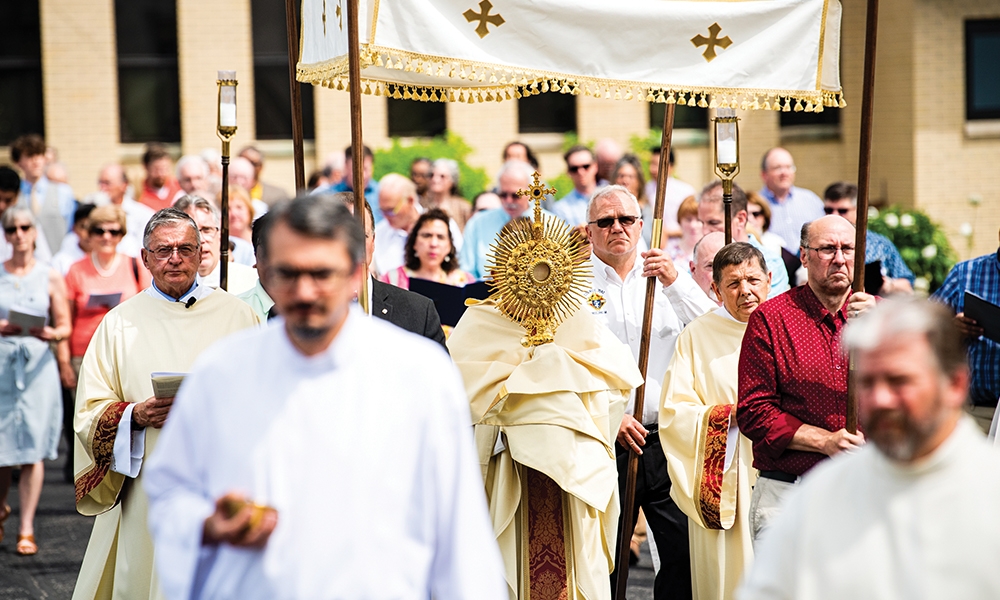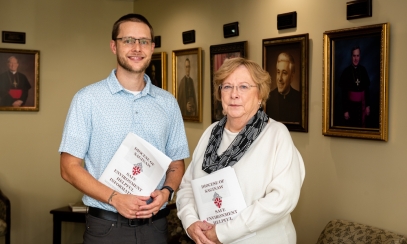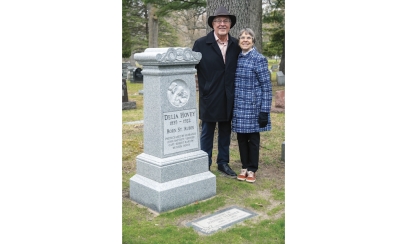
Christ’s mission is our mission
How Christ’s Mission Appeal serves you
How Christ’s Mission Appeal serves you
Dear Brothers and Sisters in Christ,
When looking back on the past fiscal year, it seems that it has gone by quickly – yet we have accomplished so much. Every week, we are doing more and serving more people within the Catholic Diocese of Saginaw.
When I say “we,” it refers to all of us. From the ministries taking place in our 56 parishes to the programs developed or administered by diocesan team members, we are all working together as co-partners in carrying on the mission of Jesus Christ.
In the following pages, you will find our annual Impact Report highlighting just a few of the many ministries that Christ’s Mission Appeal supports. These ministries focus on programs and projects that no one parish would likely have the funds or personnel to administer effectively. My chancery team is committed to being good stewards of our resources.
I am deeply grateful for your generous support of Christ’s Mission Appeal and am pleased to share this small overview of how you have impacted our ministries. Yes, together we are doing great things in the Diocese of Saginaw.
Sincerely in Christ,
+RDG
Most Rev. Robert D. Gruss, seventh bishop of the Diocese of Saginaw
Christ’s Mission Appeal serves you…
… by uncovering decades of history
By Geri Rudolf
In the three years that Mark Prindiville has worked at the Catholic Diocese of Saginaw, he has gone through lifetimes of records – and there are many more to go.
Mark, the diocesan archivist, says he had his hands full from day one.
“When I first came, the records room was a mess,” he recalled.
His first task was to try to make some sense of the piles of boxes and files that were in no particular order and some were simply labeled “stuff.”
He started to separate the diocesan records from smatterings of materials from parishes, religious orders and other organizations like the former St. Vincent’s Orphan Home, which provided food, shelter and academic education for orphaned and needy children from 1875 to 1985. With a good amount of that organization complete, Mark now is able to concentrate some of his work on offering his expertise in archiving to parishes by setting up and sharing records retention schedules for sacraments, financial documents, photos and more.
For many parishes there are also questions and confusion about how to handle the records from former parishes that were merged in the last decade.
But not all files from legacy parishes are at current parishes. In fact, interns in the diocesan archive department often work largely on documents marked as “parish files.” Intern Trevor Colosky noted that the “parish files” range from very thick files to only a few documents. While some of the files from the Diocese and parishes were in pristine condition, many were uncovered under thick dust and cobwebs.
Although there is much more organization to do, diocesan archives are now kept in a climate-controlled room. Mark noted that the archives are not just print records. There are audio-visual files as well.
Christ’s Mission Appeal partially funds the diocesan archives department.
Sometimes parish staff contact the archives department with specific requests, such as obtaining pictures of past priests who served the parish, information about church buildings, the history of their properties or even past events.
When Father Marcel Portelli, pastor at Sacred Heart Parish in Gladwin and St. Athanasius Parish in Harrison, wanted to create a history wall in the Sacred Heart Parish dining hall, he turned to Mark. Because of changes to dioceses’ borders over the years, Mark not only had to search Diocese of Saginaw records but also contacted the Diocese of Grand Rapids.
Father Portelli’s intention for the display in the community space in the church was twofold. The images of the clergy who had served the parish in the past gives a sense of history, Father Portelli said. He also hopes that the display will prompt some curiosity. Father Portelli said that his childhood home parish had a history wall, as did a parish where he served while he was in seminary. Those images sparked his interest. He did research on the lives of those long-gone priests and sisters, and that background helped him to learn about his faith and discern his vocation.
“The project really was a labor of love,” said Father Portelli. “It assures [us] that we are not forgetting our history; and it might help to inspire the future.”
Also in the archives are bound and loose volumes of the Catholic Weekly newspaper, which was an “authorized publication” for the Diocese of Saginaw but produced by an outside non-profit. The paper started in 1942 and was published regularly for 74 years.
"A diocesan archive is vastly important not only when it comes to everyday data and information retention for the Diocese of Saginaw, but it also provides the opportunity to preserve historical information about parishes and the communities that they serve,” Mark said. “We safeguard the historical importance of the churches and parishes that make up our diocese, which means we are also safeguarding the histories of families and individuals that have helped build, live and progress our faith within the Great Lakes Bay region."
8 Christ’s Mission Appeal serves you…
… Through experts supporting parish building, renovation and maintenance
By Geri Rudolf
With parish churches, rectories, parish halls and schools, there are nearly 300 buildings and properties that fall under ownership of the Catholic Diocese of Saginaw and its individual parishes. When something at one of those sites requires repair or renovation due to age or malfunction, parish leaders can face many questions and regulations.
Thanks to the support of the Office of Administrative Services, funded in part by Christ’s Mission Appeal, they do not need to navigate those things on their own. Diocesan staff and trusted consultants can help.
“We need to allow our pastors to be pastoral. We should not require them to be experts in permits and buildings and processes,” said Jane Sills, director of the diocesan Office of Administrative Services.
In addition to administrative office staff, parish and school leaders can rely on advice from the diocesan Building Commission, which consists of an architect, a civil engineer, a general contractor, an HVAC (heating, ventilation and air conditioning) professional, a banker, an expert in liturgical furniture and Catholic worship spaces and others.
Per canon law, each Catholic arch/diocese must have a Building Commission to assist parishes and advise on projects. (Canon law is a code of ecclesiastical laws governing the Catholic Church.)
All parish or school projects that exceed $25,000 are required to come to the Building Commission for review and those of $100,000 or more require additional review.
Jane stressed that the administrative services office and the advisory Building Commission are not meant to be a hindrance to parishes or schools in completing projects, but rather offer benefits and support to those starting repair or renovation projects.
For Joe Henige, the diocesan Building Commission provided assistance and leadership for a massive renovation and restoration project at his parish of St. Michael in Maple Grove.
A large renovation project at the parish, which began under guidance of the late Bishop Joseph Cistone, encountered some detours and delays. Work continued during the tenure of Bishop Walter Hurley, who served as the apostolic administrator of the Diocese following Bishop Cistone’s passing and until Bishop Robert Gruss’ arrival. The work was further delayed due to the global pandemic.
“The Building Commission was the constant during those transitions. We were able to progress in a timely manner even amid COVID,” said Joe, who also serves as the pastoral associate at St. Michael.
Bishop Gruss consecrated and blessed the renovated St. Michael Parish at a special Mass of Dedication on Dec. 19, 2021.
Jane also noted that there are some standards for work at churches that would not apply to secular projects. Therefore, in addition to advising parishes or schools about the actual safety and code requirements, permits and processes for building or renovations, diocesan staff and Building Commission members also review and make suggestions and recommendations, if appropriate, for any changes or development of worship spaces.
“This is a very collaborative team. There is no desire to add a layer of complication to any project, but to make sure that things are right from the beginning of a project,” Jane said.
The collaboration among the Building Commission, the diocesan Office of Liturgy and Father Jim Bessert and Father Pat O’Connor of the diocesan Art and Environment Committee was beneficial throughout the project, Joe said.
Renovation team leaders also relied on guidelines in “Built of Living Stones: Art, Architecture and Worship,” which is a document published by the United States Conference of Catholic Bishops. A bonus was that several of the project contractors were familiar with parameters for Catholic church buildings as some had worked on other projects in the Diocese, including the renovation of the Cathedral of Mary of the Assumption.
“We wanted it to be nice, but we also recognized that we are not a cathedral, so the partnership with the Building Commission and others was helpful,” he said.
Christ’s Mission Appeal serves you…
… through resources from the Office of Liturgy
By Geri Rudolf
Behind the scenes of any liturgy, dedicated teams are at work, ensuring the people of God are able to experience proper worship with well-formed ministers and well-planned logistics. From daily Masses at each parish to the grand celebration of a priestly ordination, the Office of Liturgy plays an important yet little-seen role.
“Having a standardized liturgy is all about unity, and it is what Jesus Christ prayed for at great length in John’s Gospel— ‘so that they may be one, as we are one, I in them and you in me,’” said Bob Zondlak, liturgical liaison for the Diocese, referencing John 17:22-23.
Each year the Diocese of Saginaw hosts about 40 special liturgies, usually presided at by Bishop Robert Gruss. These range from Masses commissioning and missioning of ecclesial lay ministers, holy hours prayed for vocations or the annual Chrism Mass, in which representatives from each parish gather to receive the blessed Holy Oils for sacramental use. These beautiful liturgies require careful planning and organization.
Whether the liturgies take place at the Cathedral of Mary of the Assumption or another parish in the Diocese, the Office of Liturgy coordinates servers, lectors, Extraordinary Ministers of Holy Communion and musicians; plans music; creates worship aids; and ensures all of the special items are in place and ready for use. These include altar cloths, wafers and wine for Holy Communion and vessels for distributing Holy Communion. For some celebrations, incense is also used. In many liturgies, diocesan priests concelebrate with Bishop Gruss, so the Office of Liturgy arranges for clean and pressed vestments to be available.
Diocesan staff work closely with parish leaders and others to coordinate the details of the events from all sides, Bob said.
In addition to the efforts for special liturgies, parishioners throughout the Diocese benefit from the work of the Office of Liturgy, which is partly funded by Christ’s Mission Appeal.
Staff offer regular training for Extraordinary Ministers of Holy Communion (EMHCs), training for lectors and others who minister at parishes. The Office of Liturgy team members also offer important resources, guidelines and materials for parishes for liturgical seasons and holy days.
For example, the sessions for EMHCs are beneficial to both people who are new to the ministry and those who have years of experience, said Judy Rasmussen of Holy Spirit Parish in Shields.
Judy, who has served as an EMHC for about 30 years, attended a training in June at her home parish, which welcomed ministers from Saginaw, Midland and Gratiot counties.
“I think (the training) was beneficial if you were new or if you’ve done this for a long time,” Judy said. “There were things that I didn’t know, and I’ve been doing this for a long time.”
EMHC training focuses on several key points, including the threefold ministry of priest, prophet, king and that all Catholics are baptized into, what it means and how to live; volunteerism versus ministry; liturgical theology based on Sacrosanctum Concilium (The Constitution on the Sacred Liturgy), one of the constitutions of the Second Vatican Council and Eucharistic theology focusing on the Real Presence of Jesus in the Eucharist.
Judy said that no matter how long one has served as an EMHC, she thinks that it would be helpful to attend a session from the Office of Liturgy about every five years.
“It’s something that you do every day or every weekend, but it’s important to renew what you are doing,” she said.
In the past year, the Office of Liturgy also embarked on a special partnership and collaboration with the diocesan Office of Parish Life and Evangelization to provide elements of the Eucharist Revival, such as seminars for priests, deacons, directors of parish life, pastoral associates/ministers, lay ministers, those who lead parish faith formation, school administrators and more.
A four-part series called “Teaching Mass” focused on the different parts of the Mass and how to celebrate them and teach others about the Mass. Each of the four sessions – the Introductory Rites; the Liturgy of the Word; the Liturgy of the Eucharist; and the Concluding Rites – were held between November 2022 and April 2023 at different parishes within the Diocese. To view the series, go to www.saginaw.org/teaching-mass-series.



